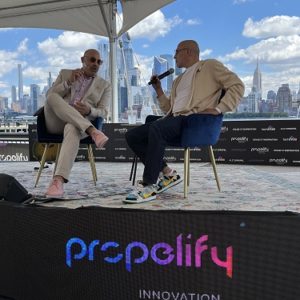Beyda Gets Specific About What Tech Startups Should Know to Receive Genacast Funding

Gil Beyda, founder and managing partner of Genacast Ventures (Philadelphia and New York), a seed fund formed in partnership with Comcast Ventures, gave attendees at the Feb. 19, 2013, Venture Association of New Jersey (VANJ) luncheon meeting in Whippany very specific criteria he uses when choosing whom to fund.
He started his discussion by explaining his background and connection to VANJ. Beyda, a former software technology consultant and serial entrepreneur who founded Real Media and several other startups, remembered pitching yet another tech startup to the VANJ in 2001. “It was a great idea, [but it was] bad timing, and it didn’t end up getting funded,” he recalled.
After Real Media was acquired in 2001, Beyda went into online advertising as CTO of Tacoda, an early behavioral-targeting ad network. Following AOL’s acquisition of Tacoda in 2007, he founded Genacast. Beyda noted that he is also personally invested in the fund.
Genacast’s goal is to fund early-stage northeast U.S. business-facing Internet technology companies with up to a million dollars, in four to six deals a year.
“Even though we are partnered with Comcast and Comcast Ventures, companies we invest in don’t have to have anything to do with Comcast or NBC Universal,” Beyda said. “However, we do work with those guys and can open those doors and make those intros,” he noted.
Beyda’s talk was entitled “Eight Keys to Yes: The Eight Questions You Need to Answer to Get Him to Write a Check.”
“More important than getting me to answer yes, it’s important to answer these questions to get your families, your significant others, to answer yes as well,” he told the young entrepreneurs in attendance.
“When I make an investment, … it’s just money. But you are investing a lot more: you are investing your time and … making a commitment to the business. First and foremost, you should be able to convince your friends and family that this is an awesome idea.”
Beyda’s eight “keys” are quite detailed. Getting his money is no simple journey:
- Be clear about the problem you are solving. “It’s even better if this problem is felt by millions of people,” said Beyda. Then it’s likely there will be a large market. Know whether the problem is well understood. Ideally, your target customers know they have a problem and that it’s big and painful. That speaks to the sales cycle. If they have a very painful problem, customers say, “Yes, I want the solution and I want it now.”
- Know your solution to the problem. What sorts of technology, services, processes, “secret sauce,” trade secrets and IP do you have? Understand that people are using other solutions to the problem today. Know how difficult it will be to move people away from current solutions. The more you have to change their behavior, the more difficult it will be to gain acceptance. Understand that you are probably not the first person who came up with this idea; someone else has likely tried it. Put context around your solution: pretend that someone else has come up with this idea before, know why it wouldn’t have worked before and what in the ecosystem, market or context will make it work now. Will it work, for example, because we all have mobile phones today and you need mobile data to make it work? Is it because we all have broadband and you need broadband for your solution?
- The team is next in importance. Said Beyda, “It’s about their ability to create the vision and execute on the vision. It’s really important that they understand the stakes. It would be amazing if they actually felt the problem in their last job or in their past.” If team members are in the industry you are addressing, it’s even better. They can then share their contacts, and access partners, potential customers, distributors and channels. The team needs to be able to lead, inspire and hire. Look for teams with the mindset that in the office each day everything is going to go wrong.
- Companies often don’t look at the real competition. Said Beyda, “Open up your competitive set and know if you threaten people who are borderline competitors who could try to enter the market.” Is it easy for them to move into your space? In that case, unlevel the playing field: “I want any company I invest in to have an unfair advantage [a unique asset] in the marketplace.” It may have contacts sewn up or patents or technology that is difficult to replicate. Know how the landscape will change after you launch: “You will affect the market by bringing your product to market.”
- Know the market ecosystem in order to maximize the opportunity and leverage the marketplace. Who will the users be? Who will the buyer be? Know the decision maker, the potential strategic and nonstrategic partners and the channel partners and distributors early on. How will you acquire customers? What are the costs of acquisition and how will those costs make sense for the business? “It helps if you come from the industry; you know what the sales cycle is, you know how to find those customers, how you message them and close them.” It’s important to know how much cash you’ll need. “We are funding you to some point in the future. At that point you will have proven some aspects of your business. If you can’t do that, it’s unlikely you’ll get more money from me unless you’ve made substantial progress,” said Beyda.
- Know how much “runway” you need at the seed stage. While you are working on your seed round, imagine what you want to put in your Series A deck. Picture it this way: I want to have X amount of customers and X amount of revenue. Work backward from that. How much time and how much money do you need? “The worst thing I can do is invest too little money and have you run out of cash,” said Beyda. Entrepreneurs don’t, however, want to raise too much, because early money is the most expensive money, and it gets the most dilution. The length of time Genacast expects to fund in a seed round is from 12 to 18 months.
- Know how to “de-risk” for the next investor coming down the line. If there is risk of uncertainty that you can build the technology product, make sure you build it for the next investor. If there is market risk (“I don’t know if people will buy it”), make sure you have buyers for the next investor. Know the key assumptions the next investor will want to see for customer acquisition costs, sales cycles and so on. It shouldn’t come as a surprise when a follow-on investor asks you a question about traction, for example.
- A somewhat controversial question is, Should entrepreneurs be thinking about the exit when they have barely started? Beyda’s response: “We don’t want you to focus on the exit. We want you to build an amazing business and delight your customers. But … it’s an important exercise to understand that you are building a valuable asset and to know to whom it will be valuable. We make our money when you exit, so we want to know that someone will find it valuable.”

